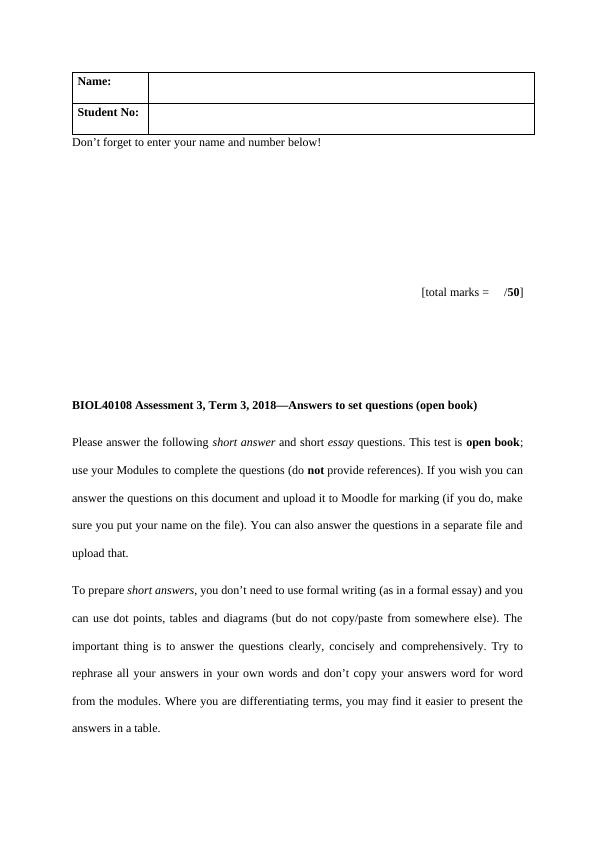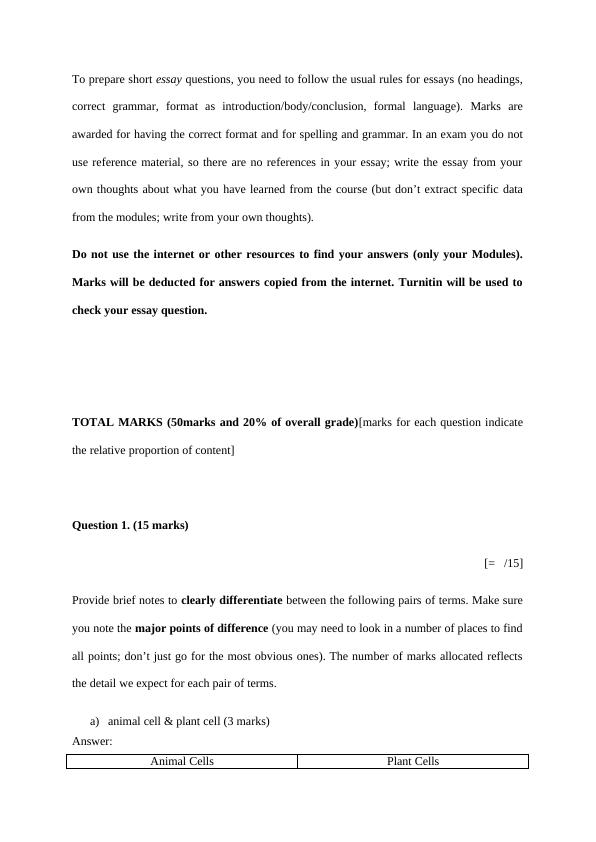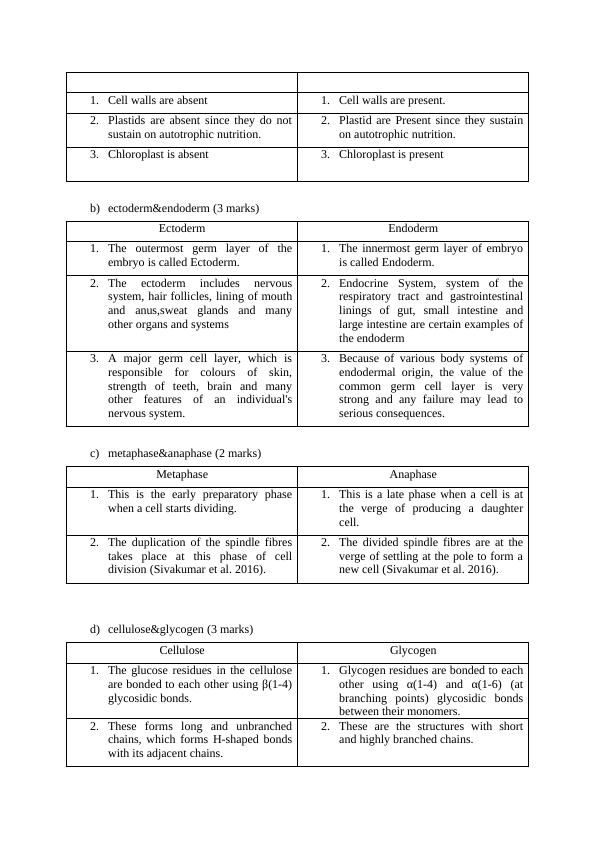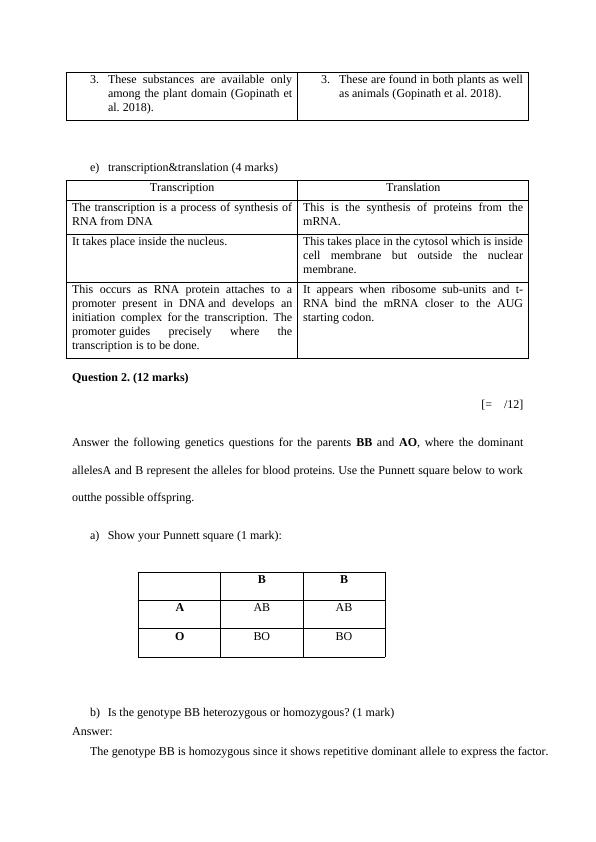BIOL40108 | Biology Assignment (document)
Answering set questions in an open book format for the Introductory Biology course at CQUniversity.
16 Pages3681 Words16 Views
Added on 2022-08-13
BIOL40108 | Biology Assignment (document)
Answering set questions in an open book format for the Introductory Biology course at CQUniversity.
Added on 2022-08-13
ShareRelated Documents
Name:
Student No:
Don’t forget to enter your name and number below!
[total marks = /50]
BIOL40108 Assessment 3, Term 3, 2018—Answers to set questions (open book)
Please answer the following short answer and short essay questions. This test is open book;
use your Modules to complete the questions (do not provide references). If you wish you can
answer the questions on this document and upload it to Moodle for marking (if you do, make
sure you put your name on the file). You can also answer the questions in a separate file and
upload that.
To prepare short answers, you don’t need to use formal writing (as in a formal essay) and you
can use dot points, tables and diagrams (but do not copy/paste from somewhere else). The
important thing is to answer the questions clearly, concisely and comprehensively. Try to
rephrase all your answers in your own words and don’t copy your answers word for word
from the modules. Where you are differentiating terms, you may find it easier to present the
answers in a table.
Student No:
Don’t forget to enter your name and number below!
[total marks = /50]
BIOL40108 Assessment 3, Term 3, 2018—Answers to set questions (open book)
Please answer the following short answer and short essay questions. This test is open book;
use your Modules to complete the questions (do not provide references). If you wish you can
answer the questions on this document and upload it to Moodle for marking (if you do, make
sure you put your name on the file). You can also answer the questions in a separate file and
upload that.
To prepare short answers, you don’t need to use formal writing (as in a formal essay) and you
can use dot points, tables and diagrams (but do not copy/paste from somewhere else). The
important thing is to answer the questions clearly, concisely and comprehensively. Try to
rephrase all your answers in your own words and don’t copy your answers word for word
from the modules. Where you are differentiating terms, you may find it easier to present the
answers in a table.

To prepare short essay questions, you need to follow the usual rules for essays (no headings,
correct grammar, format as introduction/body/conclusion, formal language). Marks are
awarded for having the correct format and for spelling and grammar. In an exam you do not
use reference material, so there are no references in your essay; write the essay from your
own thoughts about what you have learned from the course (but don’t extract specific data
from the modules; write from your own thoughts).
Do not use the internet or other resources to find your answers (only your Modules).
Marks will be deducted for answers copied from the internet. Turnitin will be used to
check your essay question.
TOTAL MARKS (50marks and 20% of overall grade)[marks for each question indicate
the relative proportion of content]
Question 1. (15 marks)
[= /15]
Provide brief notes to clearly differentiate between the following pairs of terms. Make sure
you note the major points of difference (you may need to look in a number of places to find
all points; don’t just go for the most obvious ones). The number of marks allocated reflects
the detail we expect for each pair of terms.
a) animal cell & plant cell (3 marks)
Answer:
Animal Cells Plant Cells
correct grammar, format as introduction/body/conclusion, formal language). Marks are
awarded for having the correct format and for spelling and grammar. In an exam you do not
use reference material, so there are no references in your essay; write the essay from your
own thoughts about what you have learned from the course (but don’t extract specific data
from the modules; write from your own thoughts).
Do not use the internet or other resources to find your answers (only your Modules).
Marks will be deducted for answers copied from the internet. Turnitin will be used to
check your essay question.
TOTAL MARKS (50marks and 20% of overall grade)[marks for each question indicate
the relative proportion of content]
Question 1. (15 marks)
[= /15]
Provide brief notes to clearly differentiate between the following pairs of terms. Make sure
you note the major points of difference (you may need to look in a number of places to find
all points; don’t just go for the most obvious ones). The number of marks allocated reflects
the detail we expect for each pair of terms.
a) animal cell & plant cell (3 marks)
Answer:
Animal Cells Plant Cells

1. Cell walls are absent 1. Cell walls are present.
2. Plastids are absent since they do not
sustain on autotrophic nutrition.
2. Plastid are Present since they sustain
on autotrophic nutrition.
3. Chloroplast is absent 3. Chloroplast is present
b) ectoderm&endoderm (3 marks)
Ectoderm Endoderm
1. The outermost germ layer of the
embryo is called Ectoderm.
1. The innermost germ layer of embryo
is called Endoderm.
2. The ectoderm includes nervous
system, hair follicles, lining of mouth
and anus,sweat glands and many
other organs and systems
2. Endocrine System, system of the
respiratory tract and gastrointestinal
linings of gut, small intestine and
large intestine are certain examples of
the endoderm
3. A major germ cell layer, which is
responsible for colours of skin,
strength of teeth, brain and many
other features of an individual's
nervous system.
3. Because of various body systems of
endodermal origin, the value of the
common germ cell layer is very
strong and any failure may lead to
serious consequences.
c) metaphase&anaphase (2 marks)
Metaphase Anaphase
1. This is the early preparatory phase
when a cell starts dividing.
1. This is a late phase when a cell is at
the verge of producing a daughter
cell.
2. The duplication of the spindle fibres
takes place at this phase of cell
division (Sivakumar et al. 2016).
2. The divided spindle fibres are at the
verge of settling at the pole to form a
new cell (Sivakumar et al. 2016).
d) cellulose&glycogen (3 marks)
Cellulose Glycogen
1. The glucose residues in the cellulose
are bonded to each other using β(1-4)
glycosidic bonds.
1. Glycogen residues are bonded to each
other using α(1-4) and α(1-6) (at
branching points) glycosidic bonds
between their monomers.
2. These forms long and unbranched
chains, which forms H-shaped bonds
with its adjacent chains.
2. These are the structures with short
and highly branched chains.
2. Plastids are absent since they do not
sustain on autotrophic nutrition.
2. Plastid are Present since they sustain
on autotrophic nutrition.
3. Chloroplast is absent 3. Chloroplast is present
b) ectoderm&endoderm (3 marks)
Ectoderm Endoderm
1. The outermost germ layer of the
embryo is called Ectoderm.
1. The innermost germ layer of embryo
is called Endoderm.
2. The ectoderm includes nervous
system, hair follicles, lining of mouth
and anus,sweat glands and many
other organs and systems
2. Endocrine System, system of the
respiratory tract and gastrointestinal
linings of gut, small intestine and
large intestine are certain examples of
the endoderm
3. A major germ cell layer, which is
responsible for colours of skin,
strength of teeth, brain and many
other features of an individual's
nervous system.
3. Because of various body systems of
endodermal origin, the value of the
common germ cell layer is very
strong and any failure may lead to
serious consequences.
c) metaphase&anaphase (2 marks)
Metaphase Anaphase
1. This is the early preparatory phase
when a cell starts dividing.
1. This is a late phase when a cell is at
the verge of producing a daughter
cell.
2. The duplication of the spindle fibres
takes place at this phase of cell
division (Sivakumar et al. 2016).
2. The divided spindle fibres are at the
verge of settling at the pole to form a
new cell (Sivakumar et al. 2016).
d) cellulose&glycogen (3 marks)
Cellulose Glycogen
1. The glucose residues in the cellulose
are bonded to each other using β(1-4)
glycosidic bonds.
1. Glycogen residues are bonded to each
other using α(1-4) and α(1-6) (at
branching points) glycosidic bonds
between their monomers.
2. These forms long and unbranched
chains, which forms H-shaped bonds
with its adjacent chains.
2. These are the structures with short
and highly branched chains.

3. These substances are available only
among the plant domain (Gopinath et
al. 2018).
3. These are found in both plants as well
as animals (Gopinath et al. 2018).
e) transcription&translation (4 marks)
Transcription Translation
The transcription is a process of synthesis of
RNA from DNA
This is the synthesis of proteins from the
mRNA.
It takes place inside the nucleus. This takes place in the cytosol which is inside
cell membrane but outside the nuclear
membrane.
This occurs as RNA protein attaches to a
promoter present in DNA and develops an
initiation complex for the transcription. The
promoter guides precisely where the
transcription is to be done.
It appears when ribosome sub-units and t-
RNA bind the mRNA closer to the AUG
starting codon.
Question 2. (12 marks)
[= /12]
Answer the following genetics questions for the parents BB and AO, where the dominant
allelesA and B represent the alleles for blood proteins. Use the Punnett square below to work
outthe possible offspring.
a) Show your Punnett square (1 mark):
B B
A AB AB
O BO BO
b) Is the genotype BB heterozygous or homozygous? (1 mark)
Answer:
The genotype BB is homozygous since it shows repetitive dominant allele to express the factor.
among the plant domain (Gopinath et
al. 2018).
3. These are found in both plants as well
as animals (Gopinath et al. 2018).
e) transcription&translation (4 marks)
Transcription Translation
The transcription is a process of synthesis of
RNA from DNA
This is the synthesis of proteins from the
mRNA.
It takes place inside the nucleus. This takes place in the cytosol which is inside
cell membrane but outside the nuclear
membrane.
This occurs as RNA protein attaches to a
promoter present in DNA and develops an
initiation complex for the transcription. The
promoter guides precisely where the
transcription is to be done.
It appears when ribosome sub-units and t-
RNA bind the mRNA closer to the AUG
starting codon.
Question 2. (12 marks)
[= /12]
Answer the following genetics questions for the parents BB and AO, where the dominant
allelesA and B represent the alleles for blood proteins. Use the Punnett square below to work
outthe possible offspring.
a) Show your Punnett square (1 mark):
B B
A AB AB
O BO BO
b) Is the genotype BB heterozygous or homozygous? (1 mark)
Answer:
The genotype BB is homozygous since it shows repetitive dominant allele to express the factor.

End of preview
Want to access all the pages? Upload your documents or become a member.
